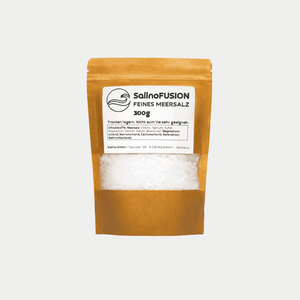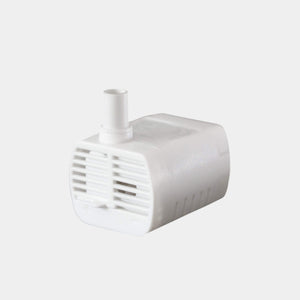When air is more than just breathing
It often starts with something invisible. A tightness in the chest. A dry, scratchy throat. A persistent cough. For millions of people in Europe, breathing isn't something they take for granted. Asthma, COPD , chronic bronchitis, or simply permanently irritated lungs caused by particulate matter, heating air, or allergies – they all share a need for relief. For a place, a state where air is once again a good thing.
Salty air is not only considered beneficial, but in many cases, medically beneficial. Numerous studies demonstrate that salt aerosols have anti-inflammatory effects, loosen mucus, and can clear the respiratory tract. Halotherapy, the targeted use of salty air, has therefore enjoyed growing popularity for years – and today comes in a variety of forms.
But which form is the right one? A vacation by the sea? Artificially generated saline air in inhalers? A trip to a salt cave or using a mini graduation tower at home?
In this article, we'll take you on a journey through four different ways to get salt air—not to judge, but to understand. Because as different as the methods are, so individual are their effects.
1. Sea air: healing with expansiveness
 Sometimes it's enough to just be there. No pressing of a button, no instructions – just you, the wind, and the salty light. The classic form of salt air therapy is also the most original: spending time by the sea.
Sometimes it's enough to just be there. No pressing of a button, no instructions – just you, the wind, and the salty light. The classic form of salt air therapy is also the most original: spending time by the sea.
Especially on coasts with high surf, such as the North Sea or the Atlantic, the waves create tiny saltwater droplets, so-called aerosols. These penetrate deep into the respiratory tract, where they have an expectorant, anti-inflammatory, and calming effect. This effect is amplified by the wind—what doctors refer to as a "maritime stimulating climate."
But not all seas are created equal. While the Baltic Sea, for example, offers less intense aerosol concentrations due to its more sheltered location, the more rugged coasts are particularly healing. Studies show that even a few days' stay can lead to measurable improvements in lung function – especially in asthmatics and children.
The downside? They lie not in the effect, but in the access. Not everyone can afford to travel to the coast regularly. And the effect vanishes – with the train ticket back inland.
2. Inhalers and saline nebulizers: Control in concentrated form
 For those who can't reach the sea, there are technological solutions. Inhalers and saline nebulizers are now common treatments for respiratory diseases. They produce a fine mist of saline solutions—usually in medical concentrations—and deliver it directly via a mouthpiece or mask.
For those who can't reach the sea, there are technological solutions. Inhalers and saline nebulizers are now common treatments for respiratory diseases. They produce a fine mist of saline solutions—usually in medical concentrations—and deliver it directly via a mouthpiece or mask.
The major advantage lies in the control: dosage, frequency, concentration – everything can be individually tailored. Health insurance companies often cover the costs of certified devices for chronic illnesses.
But this precision comes at a price: The effect remains localized. It usually only affects the upper respiratory tract; sustained hydration of the entire lungs, like at the seaside, is rarely achieved. Furthermore, its use requires discipline: inhale, clean, and refill several times a day.
The emotional aspect is also missing. What happens unconsciously during a walk along the dike becomes a medical procedure here. For some, this is exactly what's right. For others, it feels foreign.
3. Mini graduation towers for the home: salt chamber in the living room?
 An increasingly popular compromise between nature and everyday life are so-called mini graduation towers. Inspired by the large graduation towers in spa towns like Bad Salzuflen or Bad Dürrenberg, they generate saline indoor air through evaporating brine water. Some models use real blackthorn twigs, others use porous stones or special technology.
An increasingly popular compromise between nature and everyday life are so-called mini graduation towers. Inspired by the large graduation towers in spa towns like Bad Salzuflen or Bad Dürrenberg, they generate saline indoor air through evaporating brine water. Some models use real blackthorn twigs, others use porous stones or special technology.
The advantages? It's passive. Simply leave the device running while you read, sleep, or work. Unlike spot inhalation, the entire room is gently enriched with salt air . This can be a real relief for people with minor ailments or as a preventative measure in polluted city air.
The critical point remains: the aerosol concentration is lower than at the seaside, making its effects more difficult to measure. Nevertheless, many users report better sleep, clearer airways, and a more pleasant indoor climate—especially with continuous use.
4. Salt caves & salt chambers: spa resort in compact format
 It sounds almost esoteric – and yet there's a lot of physics behind it: Salt chambers or salt caves are rooms whose walls, floors, and ceilings are lined with tons of rock salt. An aerosol device is often used in addition, releasing fine brine droplets into the air. The goal: a microclimate similar to that found in natural salt mines or coastal regions.
It sounds almost esoteric – and yet there's a lot of physics behind it: Salt chambers or salt caves are rooms whose walls, floors, and ceilings are lined with tons of rock salt. An aerosol device is often used in addition, releasing fine brine droplets into the air. The goal: a microclimate similar to that found in natural salt mines or coastal regions.
Anyone entering a salt cave often experiences something unexpected: The air has a slightly metallic taste and is noticeably dense, cool, and dry. And it is precisely this combination—dry, salty air at a consistent temperature—that, according to medical literature, can penetrate particularly deeply into the lower respiratory tract. In countries like Poland and Russia, this form of halotherapy has been part of the medical treatment for asthma, COPD, and atopic dermatitis for decades.
But as effective as salt chambers can be, they remain temporary. A session usually lasts 45 minutes, and regular visits are necessary. And not everyone feels comfortable in the artificial cave atmosphere. Some find it oppressive, others a soothing retreat. The effect is therefore not only physiological—it is also psychological.
5. What really works – and what really suits you
The crucial question is not just: “What works?” but: “What works for me?” Because just as each person’s respiratory system is individual, so too do their bodies and minds react differently to each form of therapy.
Some need the sea because it not only heals, but also reminds them of lightness, childhood, and breathing deeply. Others find the daily use of a miniature graduation tower a routine that alleviates their symptoms without restricting their lives. Still others need the medical focus of an inhaler because their body demands clear, targeted help.
A combination of these often helps. Those who use a mini-grader or a saline nebulizer in their daily routine, for example, benefit doubly from an occasional coastal vacation. And those who regularly visit salt chambers can prolong the effects at home by exposing themselves to salty air.
In the end, it's not about choosing the "best" method. It's about choosing the right one. The one you can live with in your daily life. The one that doesn't feel like therapy, but rather like a piece of freedom.
Conclusion: Breathing as a posture – not as a measure
In a world that accelerates, demands, and overwhelms us every day, breathing often becomes a secondary concern. But anyone who begins to consciously engage with their breathing—whether due to a diagnosis, exhaustion, or the silent need for more space—quickly realizes: breathing is more than just taking in air. It's a path back to yourself.
Salt air can be a silent companion on this journey. Whether in the form of wild sea air, precise inhalation, a contemplative salt chamber, or unobtrusive room therapy in the living room – each approach offers its own unique qualities. No method is equally effective for everyone. And no one method can replace everything.
What matters is coherence. Daily life, rhythm, personal feeling. The desire not to just function all the time, but to breathe deeply—literally.
And if the journey to the sea is too far? Then it's worth looking into technical aids that bring salt air into everyday life. One such solution is the so-called mini-saline – a device that uses 3D printing to enable passive salt air therapy. No noise, no filters, no effort. It doesn't replace a graduation tower or a sea breeze – but it can be a start. A first step toward a life with more air.
Because sometimes healing doesn't begin with a prescription. It begins with a breath that finally feels good again.
Disclaimer
This article is for general information purposes only and is not a substitute for medical advice. If you have any health concerns, please consult a doctor .



